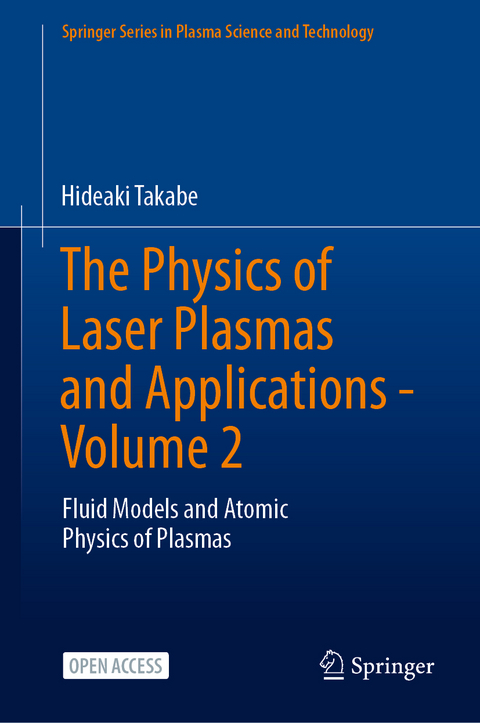
The Physics of Laser Plasmas and Applications - Volume 2
Springer International Publishing (Verlag)
978-3-031-45472-1 (ISBN)
This open access book (Volume 2) is part of the series "The Physics of Laser Plasmas and Applications." It serves as an introduction to the physics of compressible hydrodynamics, which is used to describe the temporal evolution of plasmas generated by intense laser irradiation of solid surfaces. For the benefit of students and young researchers, the book presents the fundamental equations and provides a comprehensible explanation of solutions to intricate fluid phenomena. It builds upon the concept of plasma generation through the heating of matter via the classical absorption of a laser, as expounded in Volume 1. The high-temperature plasma resulting from the laser interaction manifests in diverse hydrodynamic occurrences like shock waves and expansion waves.
The initial sections of this book expound the essentials of compressible hydrodynamics, magnetohydrodynamics (MHD), and the physics of shock waves. The transfer of laser energy within an expanding plasma towards regions of higher density is achieved through electron and X-ray transport mechanisms. In both instances, conventional diffusion models prove inadequate, necessitating mathematical frameworks founded on the Boltzmann equation. The conveyed energy engenders ablation pressure, equivalent to tens of millions of atmospheres, on the solid surface. This pressure initiates powerful shock waves propagating through the solid material. The propagation of these shock waves is delineated for scenarios involving planar and spherical geometries. The text also introduces various solutions pertaining to convergent and divergent shocks in spherical geometries using self-similar models.
The discourse then shifts towards ionization and related atomic processes, which govern the dynamics of plasmas created by laser irradiation of mid-Z and high-Z solids. The quantum mechanics of partially ionized atoms and their associated atomic processes are elucidated. Concluding the book is an exploration of the physics of warm dense matter (WDM) - an electron system characterized by quantum-mechanical, many-body interactions. The study of high-density plasmas featuring temperatures around 1 eV is undertaken through the lens of density functional theory (DFT). The theoretical breakdown of experimental data acquired via the X-ray free electron laser (X-FEL) is also provided.
In essence, this second volume of the series amalgamates a comprehensive understanding of compressible hydrodynamics, shock wave physics, ionization processes, energy transfer, and the realm of warm dense matter. It equips readers to delve into the intricacies of plasma physics and laser interactions while utilizing modern theoretical frameworks and experimental methodologies.
This is an open access book.
lt;p>Dr. Hideaki Takabe is a Professor Emeritus at the Institute of Laser Science, Osaka University. He obtained his Ph.D. in the field of laser implosion fusion theory from Osaka University. Following his time at the Max Planck Institute for Plasma Physics and the University of Arizona, he focused on theoretical and computational research in laser fusion and laboratory astrophysics at ILE, Osaka University. After opting for early retirement, he relocated first to the Helmholtz Zentrum Dresden Rossendorf (HZDR) in Dresden and subsequently to the National Taiwan University in Taipei.
His research pursuits encompass a range of disciplines, including plasma physics, laser fusion, computational physics, and laboratory astrophysics. Notably, his early contributions to the field of ablative stabilization of hydrodynamic instabilities have become widely recognized as the Takabe formula. He stands as a trailblazer in the realm of laboratory astrophysics driven by intense lasers. His accomplishments include being recognized as a Fellow of the American Physical Society and receiving prestigious awards such as the Edward Teller Award (from ANS) and the John Dawson Award (from APS).
How to model the fluids of non-ideal plasmas.- Basic equations of plasma fluid.- Atomic process in plasmas.-Physics of charged particle transport.- Physics of radiation transport.- One-dimensional plasma fluid dynamics.- Physics of high-density plasmas.
| Erscheinungsdatum | 30.03.2024 |
|---|---|
| Reihe/Serie | Springer Series in Plasma Science and Technology |
| Zusatzinfo | XVII, 455 p. 216 illus., 134 illus. in color. |
| Verlagsort | Cham |
| Sprache | englisch |
| Maße | 155 x 235 mm |
| Themenwelt | Naturwissenschaften ► Physik / Astronomie ► Plasmaphysik |
| Naturwissenschaften ► Physik / Astronomie ► Theoretische Physik | |
| Schlagworte | Atomic Process • High Density Plasma • High Energy Density Physics (HED, HEDP) • hydrodynamic instability • open access • Plasma Fluid • Strongly coupled plasma |
| ISBN-10 | 3-031-45472-3 / 3031454723 |
| ISBN-13 | 978-3-031-45472-1 / 9783031454721 |
| Zustand | Neuware |
| Haben Sie eine Frage zum Produkt? |
aus dem Bereich

